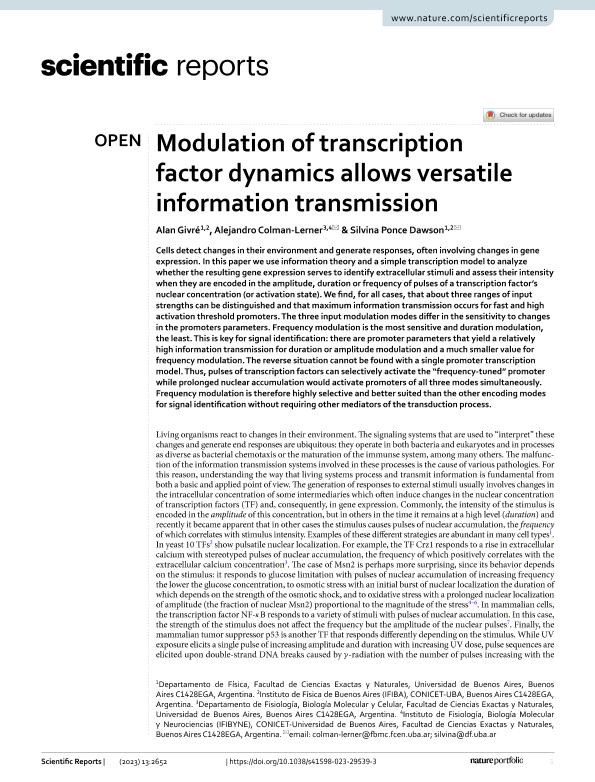Artículo
Modulation of transcription factor dynamics allows versatile information transmission
Fecha de publicación:
02/2023
Editorial:
Nature
Revista:
Scientific Reports
ISSN:
2045-2322
Idioma:
Inglés
Tipo de recurso:
Artículo publicado
Clasificación temática:
Resumen
Cells detect changes in their environment and generate responses, often involving changes in gene expression. In this paper we use information theory and a simple transcription model to analyze whether the resulting gene expression serves to identify extracellular stimuli and assess their intensity when they are encoded in the amplitude, duration or frequency of pulses of a transcription factor’s nuclear concentration (or activation state). We find, for all cases, that about three ranges of input strengths can be distinguished and that maximum information transmission occurs for fast and high activation threshold promoters. The three input modulation modes differ in the sensitivity to changes in the promoters parameters. Frequency modulation is the most sensitive and duration modulation, the least. This is key for signal identification: there are promoter parameters that yield a relatively high information transmission for duration or amplitude modulation and a much smaller value for frequency modulation. The reverse situation cannot be found with a single promoter transcription model. Thus, pulses of transcription factors can selectively activate the “frequency-tuned” promoter while prolonged nuclear accumulation would activate promoters of all three modes simultaneously. Frequency modulation is therefore highly selective and better suited than the other encoding modes for signal identification without requiring other mediators of the transduction process.
Palabras clave:
INFORMATION TRANSMISSION
,
TRANSCRIPTION
,
AMPLITUDE
,
FREQUENCY
Archivos asociados
Licencia
Identificadores
Colecciones
Articulos(IFIBA)
Articulos de INST.DE FISICA DE BUENOS AIRES
Articulos de INST.DE FISICA DE BUENOS AIRES
Articulos(IFIBYNE)
Articulos de INST.DE FISIOL., BIOL.MOLECULAR Y NEUROCIENCIAS
Articulos de INST.DE FISIOL., BIOL.MOLECULAR Y NEUROCIENCIAS
Citación
Givré, Alan Matías; Colman Lerner, Alejandro Ariel; Ponce Dawson, Silvina Martha; Modulation of transcription factor dynamics allows versatile information transmission; Nature; Scientific Reports; 13; 1; 2-2023; 1-13
Compartir
Altmétricas




